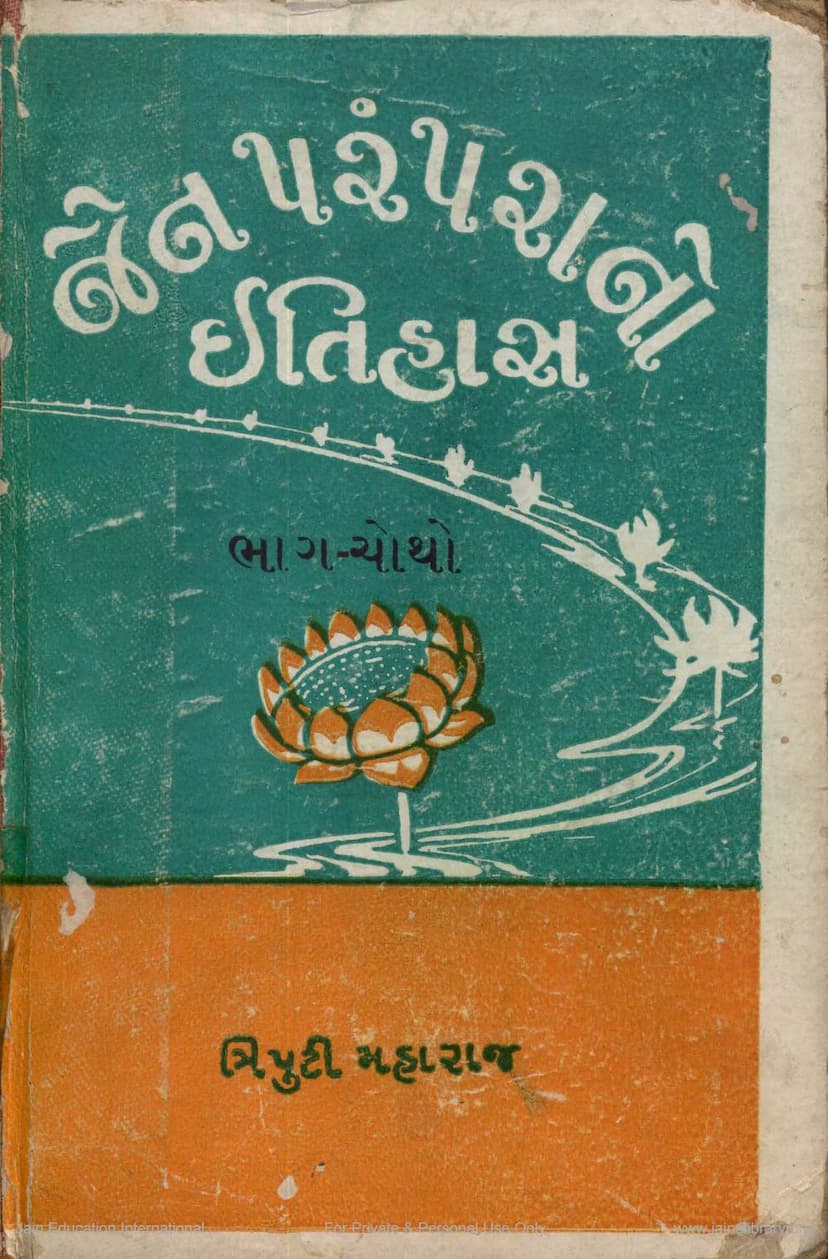Jain Paramparano Itihas Vol 4
Added to library: September 2, 2025

Summary
Here's a comprehensive summary of the Jain text "Jain Paramparano Itihas Vol 4" by Darshanvijay, Gyanvijay, and Nyayvijay, based on the provided pages:
Book Title: Jain Paramparano Itihepas Vol 4 (History of Jain Tradition Vol 4) Author(s): Muni Shri Darshanvijayji Maharaj, Muni Shri Gyanvijayji Maharaj, Muni Shri Nyayvijayji Maharaj Publisher: Charitra Smarak Granthmala Period Covered: Vikram Samvat 1500 to 1900 (Approximately 1444 CE to 1844 CE)
Overall Purpose and Scope:
This volume, the fourth in a series, aims to provide a detailed historical account of the Jain tradition. The authors, Muni Darshanvijay, Muni Gyanvijay, and Muni Nyayvijay (collectively referred to as the "Tripuți Maharaj"), embarked on this ambitious project to systematically present the history of Jainism over a period of 400 years (Vikram Samvat 1500-1900). Their goal is to document the key figures, events, traditions, institutions, and significant developments within the Jain community, thereby illuminating the rich heritage and cultural impact of Jainism in India.
Key Themes and Content Areas:
- Chronological Scope: The book meticulously covers the period from Vikram Samvat 1500 to 1900, offering insights into the evolution and activities of the Jain tradition during these centuries.
- Comprehensive Historical Narrative: The authors intend to present a balanced historical record, encompassing:
- Jain Acharyas and Munis: Biographies, contributions, and spiritual lineages of prominent Jain monks and spiritual leaders.
- Royal and Noble Patronage: The role of kings, ministers, and influential figures in supporting Jainism.
- Merchants and Patrons: The significant contributions of wealthy Jain laypeople (Shethiyas) who funded the construction of temples, libraries, and the publication of scriptures.
- Scholars and Intellectuals: The intellectual pursuits, literary works, and philosophical discussions within the Jain tradition.
- Cities and Pilgrimage Sites (Tirthas): The establishment, development, and importance of various Jain settlements and pilgrimage centers.
- Jain Sects and Traditions: The emergence, development, and interactions of different Jain sects and traditions (e.g., various gachhas).
- Significant Events: Historical occurrences such as major religious assemblies (mahasabha), disputes, and prominent constructions.
- Scriptural and Literary Contributions: The creation, preservation, and dissemination of Jain literature.
- Authorial Intent and Motivation: The authors were inspired by the need to preserve and propagate Jain history and philosophy. They had extensive interactions with scholars and scientists who recognized the potential of Jain principles for promoting peace and cultural understanding. They believed that disseminating Jain teachings could reduce conflict and foster global harmony. The publication of this history is seen as a way to reconnect India with its ancient Aryan culture.
- Challenges and Resilience: The authors detail the personal health challenges they faced during the project, including the passing of Muni Nyayvijayji, and the health issues of Muni Gyanvijayji and Muni Darshanvijayji. Despite these setbacks, they were driven by their dedication to the work and received crucial support from various individuals and institutions, enabling them to continue and complete this volume.
- Specific Examples of Content (as indicated by page introductions and the table of contents): The volume delves into detailed accounts of various gachhas (lineages or sub-sects) such as Vadgach, Mandevgach, Khartargach, Tapagach, and Anchalgach, tracing their lineages (pattavalis). It also discusses sub-sects like Kadwamat, Lokamat, Sthanakvasi, and Terapanthi. The text highlights the contributions of influential figures like Hirayug Suri and covers the periods associated with them. The detailed index of events, people, and places suggests a granular approach to historical documentation. The preface also mentions the detailed coverage of Jain history from Bhagavan Mahavir Swami up to Vikram Samvat 1596, and then continues the narrative. The content is rich with specific details about patrons, spiritual leaders, and the historical context of their activities.
Key Figures Mentioned:
- The "Tripuți Maharaj": Muni Darshanvijayji, Muni Gyanvijayji, and Muni Nyayvijayji, the authors who dedicated themselves to this project.
- Pujya Upadhya Shri Dharamsagarji Maharaj: The disciple of whose lineage Muni Darshanvijayji belongs.
- Pujya Punyas Shree Abhay sagarji Maharaj: Wrote the preface.
- Pujya Muni Shri Mitranand Sagarji Maharaj: Played a role in the publication of the fourth part.
- Pujya Muni Shri Bhadrasenvijayji (Nitivijayji) Maharaj: Mentioned in relation to the preface and the publication of the fourth part.
- Pandit Ambalal Premchand Shah: A grammar scholar and historian who took responsibility for the press copy and proofreading.
- Pandit Ratibhai and Pandit Balabhai (Jaybhikhu): Described as inspiring figures throughout the project.
- Dr. Nanalal Bhailal: Mentioned for his care in improving the authors' health and allowing them to continue the work cautiously.
- Shri Manubhai Jesingbhai Seth: A generous donor who supported the publication.
- Pandit Vikashvijay Ganij and Muni Chandrodayvijay: Supported the authors.
- Tapswi Sadhviji Shrimanjulashriji, Sadhvi Madhukantashriji, and Sadhvi Madhulataashriji: Provided devotional support.
Editorial and Publication Details:
- First Edition: Vir Samvat 2509, Vikram Samvat 2039, CE 1983.
- Price: 35 Rupees.
- Publisher: Shri Charitra Smarak Granthmala, Bhavnagar.
- Printers: Dharmalabh Printers, Bhavnagar.
Overall Significance:
"Jain Paramparano Itihas Vol 4" is presented as a vital contribution to Jain historiography. It aims to consolidate scattered historical information, provide solutions to historical puzzles, and connect historical gaps within the Jain tradition. The authors emphasize the importance of understanding this history to inspire future generations and to appreciate the sacrifices and dedication of their ancestors in preserving and propagating Jain principles. The volume is meticulously researched and aims to be a standard reference for anyone interested in the rich history of Jainism.